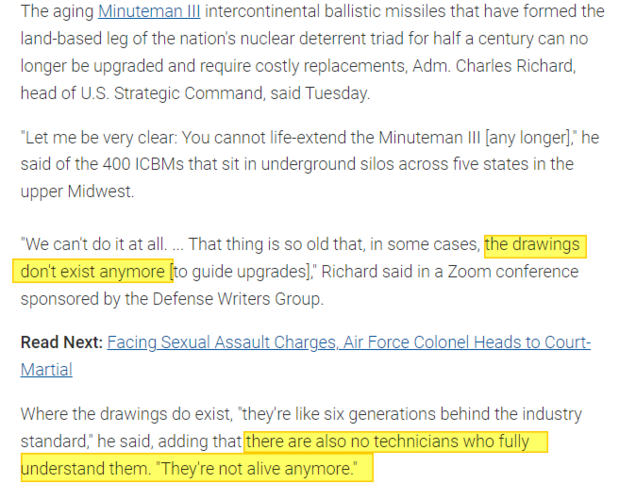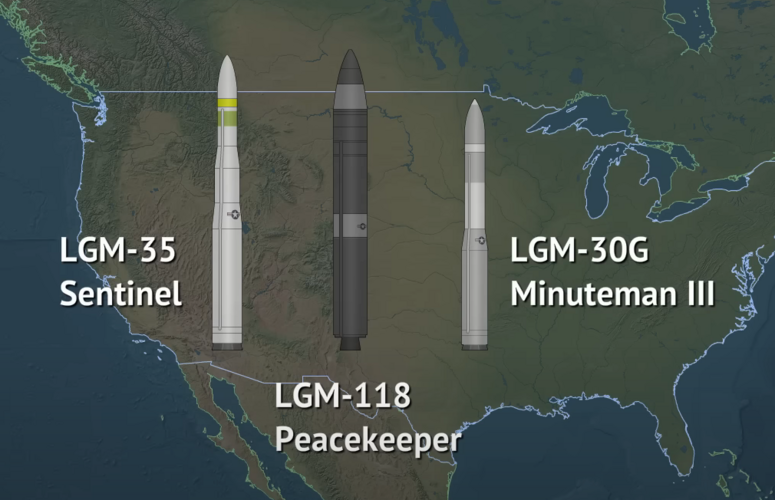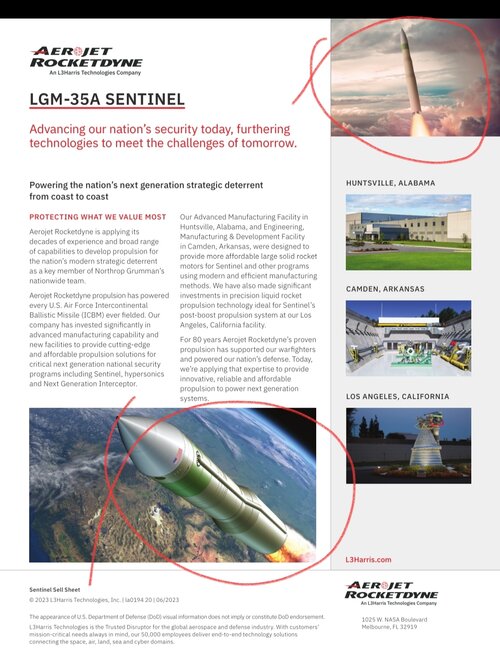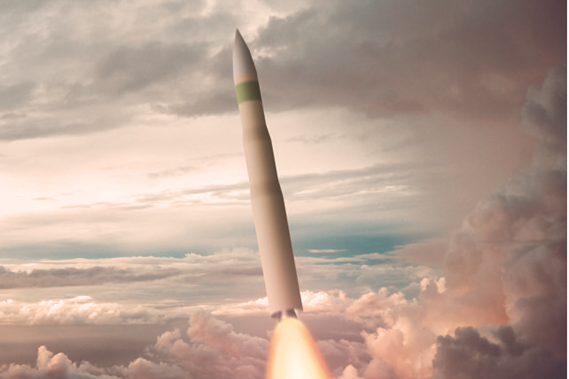- Does the industrial base exist to provide Tridents over and above the Navy's requirements? - Yes, the line is currently running making a small number of rocket motors per year, over and above the number of rockets that need to be replaced due to age-out. Those "extra" motors are then fired on test stands. The proposal is for 8-12 additional complete missiles a year for 4-6 years. 50 birds and 5 C&C sets because the USAF does one launch capsule per 10 silos.
- What's required to make USAF RVs work with Trident PBPVs? - We're not playing that game. This proposal uses complete Trident D5LE missiles, including the USN Mk4 or Mk5 RVs. The USN/DOE has a pile of extra RVs available due to downloading the Tridents from 14 RVs to 4 RVs per missile.
- How much civil engineering work would be required to configure the silos for such a large missile? - None, the inner diameter of the MM hot launch silo is approximately 15 feet. You suspend the Trident launch capsule (same design as a single missile tube) inside the MM silo using existing mounting points. There might be some odd bits fitting the Trident command and control system into the USAF command capsules, but that's not pouring concrete or anything.
- What's the delay needed to rewrite the environmental assessment? - minimal rewrite, as far as I know. 90 day comment period, usually 90 days to evaluate, final EIS goes live in ~6months from draft.
- Can the C3I be adapted to work with the rest of the Air Force C&C infrastructure, and if so, at what cost? - We're using the complete Trident submarine control package, which natively talks to STRATCOM. No modifications or translator boxes required.
- How much more will it cost in terms of maintenance? Do we have the infrastructure to routinely transport a 135,000 lb. vehicle from an integration site to East BF, South Dakota? - No additional maintenance costs, the systems are effectively "wooden rounds" and are left in the capsules. I'm unsure of the total number of bigass trucks used to haul Trident missiles on base that could be available to use for essentially two missile moves. One move from SWFPAC in Washington state on Interstate 90 to the prepped silos in East BF SoDak, and a second move some 10 years later to remove the missiles from USAF service and drop them into Columbia-class boats either in Georgia or Washington state. Advantage of Trident over MM/Sentinel is that Trident is significantly shorter, so is less complicated to move (~55ft long trailer, not ~75-80ft long trailer). Each base is known to have a minimum of two of those trucks/trailers and I assume more like 12. Convoy security during the missile moves is no different than what the USAF already deals with, the missiles would just come from a different location.
- Since we don't know the actual capabilities of the LGM-35, what newer technologies might we be giving up to get the Tridents? - None, this is a temporary fix to give Sentinel time to mature. Tridents dropped into MM silos for about a decade.
- How much is all of this going to cost and what does the USAF/DoD/Federal Government give up to get it? - I don't have access to cost docs, but this is all either stuff that the US is buying already or is going to have to buy for the Columbia class in a few years. The only extra expense would be the land launch capsule. All other costs are either coming a little earlier or are already budgeted for.
These arguments are missing some significant factors.
1. The fundamental problem with a land-based Trident is it completely destroys the dissimilar redundancy required of the strategic force. If a major test failure were to occur, or a major manufacturing problem was discovered, or it is discovered that there is a major vulnerability of the weapon that either could or is being actively exploited by an adversary that results in a strategic weapon system being rendered even temporarily ineffective, that is a major problem. When you have two dissimilar weapons, the probability of such an event affecting two weapons simultaneously is extraordinarily unlikely and mitigated by the existence to two independent systems. With a single weapon system, that probability, as low as it is, is totally unacceptable. Both Trident and Minuteman have had test failures in the last decade; while neither have resulted in either system being grounded, the potential there still exists. The presence of a minimal sustainment production capacity for critical components does not change this.
2. Trident was for some time downloaded due to the combination of a reduced threat environment and desire to reduce operational and sustainment costs. The threat environment in the last two decades has radically changed, and so has the Navy's targeting plans. Furthermore, the current force was built to provide reserve warheads for the submarine force, not an additional land-based force. The W76 and W88 also do not meet Air Force safety requirements, as does the missile itself, but we'll get to that in a moment.
3. Significant work would be required. One of the biggest obstacles for the LGM-35 is reconditioning and replacing much of the hardware both in the silo facilities and the infrastructure connecting those silos to their control centers; that work would still have to be done for a land-based Trident. Furthermore, the Trident command and control system was not designed for a land-based application and would require significant rework. The guidance system of the missile in particular has been noted as a significant issue. Trident II's accuracy is predicated on a series of very accurate gravitometric surveys performed in the 1980s that was limited to only a partial (though still expansive) set of potential patrol areas and launch trajectories. Outside of those surveyed areas, D5 accuracy was reduced significantly. Certifying the weapon for land based use would require a new set of surveys for at least a majority of target sets, at significant cost and delay to fielding.
4. An environmental review for a land-based Trident would be extensive. Neither the weapon nor its warheads meet safety requirements for a land-based weapon. Trident uses a higher energy, detonable propellant in order to meet range requirements while remaining within Navy packaging requirements. This is acceptable in a Navy application where the consequences of a detonation either in flight or aboard a vessel would be limited and almost certainly not bring harm to civilians, for an Air Force weapon the potential consequences for a failure of even an unarmed weapon are much greater. Furthermore, neither of the warheads available for Trident possess either a fire-resistant pit or utilize insensitive high explosives, thus the potential consequences of an accident with an armed warhead are much greater. This problem cannot be fixed by simply mounting the weapon with the W78 or W87, since neither reentry vehicle would fit. With these issues, an environmental review of a land-based Trident would likely be prolonged and not guaranteed to be successful.
5. Maintenance costs are a minor consideration on this topic, though transporting a heavier, wider, less safe weapon across the country presents some significant issues.
6. What does this "temporary solution" achieve here? The Minuteman force is aging, but is still capable of meeting Air Force needs into the 2030s. A land-based Trident would take most of a decade to deploy in actuality after all the reviews and modifications required to both the facilities and weapon system. At which point Sentinel is well into flight testing and a number of Minuteman facilities have either been or are in the process of being renovated for it. After which the modifications for a land-based Trident will have to be torn out and replaced with Sentinel equipment.
7. So in actuality you don't know, and are simply guessing. The idea of a common missile were studied in 2015 by DOD, with the findings reported to Congress. Said study, the Report on Strategic Missile Commonality, has never been released publicly, but Congressional testimony by Admiral Benedict alluded to many of these issues. Though maybe you can ask FAS, since they managed to acquire the study, not that they will ever release it since it undermines many of their pro-common missile arguments.





